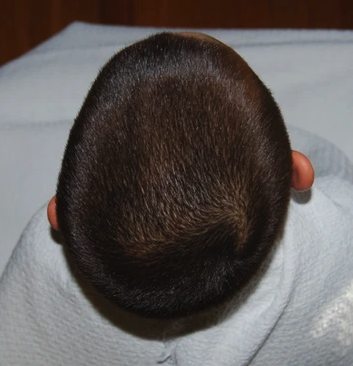A recurring question I am asked is how head asymmetry looks in an older child or an adult. My answer to this question is always, "How many older kids or adults do you know or have you seen in your life with a visible head asymmetry." Most parents seem a bit stumped and, after some deliberation, come to the same conclusion I did years ago- almost none. Does this mean that all head flattening resolves with growth and time? Not at all. There are many studies that show up to 12-15% of adults have enough residual head asymmetry to be classified as plagiocephaly (CVAI > 3.5%). Moreover, we see many adults with brachycephaly (search group posts for "adult brachycephaly" to see these). So how do we reconcile these seemingly conflicting facts- head asymmetry and flattening can persist into adulthood BUT most of us have never seen an adult with a noticeable head asymmetry? Simple. There are three primary ways that head asymmetry LOOKS less obvious with growth. The first that there may be real improvement in the actual asymmetry with growth. There are a number of studies that support this, but the degree of ABSOLUTE improvement is unpredictable.
The second is the effect of growth itself. We know that head flattening tends to peak in severity at around 4-5 months, the time infants acquire more independent mobility and are able to move themselves off the flat spot. Assume the the asymmetry does not improve at all , a fixed amount of flattening will look progressively less severe as the head size gets bigger. This is RELATIVE improvement and is the same reason that the asymmetry calculation used by many helmet shops, CVAI (a ratio between the absolute head asymmetry CVA and the long axis), consistently goes down with growth EVEN IF the absolute asymmetry, CVA, does not improve.
The third reason, and perhaps the most important factor, is the change in visual perspective on the head as a child grows. In infants, we consistently see the head from the top down, a vantage that makes any head asymmetry the most conspicuous because it is seen in a plane perpendicular to that of the asymmetry. But as the child grows, the head is increasingly viewed from the back or sides, in a plane that is mostly parallel with that of the asymmetry. This makes the asymmetry very difficult to visualize. By analogy, consider a column of blocks stacked at different heights. Viewed from the side, a plane perpendicular to the asymmetry, the difference in block height is easy to see. But viewed from the top, a plane parallel to the plane of the asymmetry, one cannot tell the if the stack is uniform or not. See the illustration below. Also, the picture of one of my patients with asymmetrical brachycephaly. While the brachycephaly aspect is notable both from the back or the top, the plagiocephaly component is not.




Comments